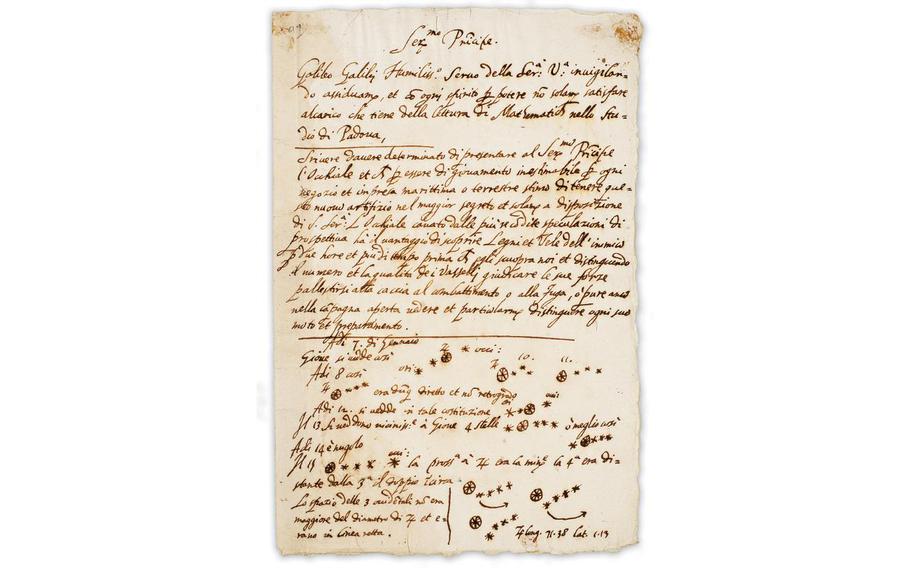
For nearly a century, the University of Michigan boasted Galileo’s Jupiter sketch as one of its “jewels.” But it was a fake, written not in the early 1600s by the father of modern astronomy but more than 300 years later by an infamous forger. (Facebook)
Using his newly built telescope, Galileo Galilei gazed up at the sky in January 1610, spotted several bright objects around Jupiter and spent weeks plotting how they changed positions each night. When he sketched how he imagined those moving objects would look to someone above Jupiter, he realized they were moons.
It was the first time in history that someone had documented a celestial body orbiting a planet that wasn't Earth, and for nearly a century, the University of Michigan boasted Galileo's Jupiter sketch as one of its "jewels."
"This single-leaf manuscript is one of the great treasures of the University of Michigan Library," the university wrote in a description of the document. "It reflects a pivotal moment in Galileo's life that helped to change our understanding of the universe."
Then, in May, a university curator received an email from Nick Wilding.
Wilding, a professor of history at Georgia State University, wrote to express "serious doubts" about the authenticity of the Galileo manuscript, library officials wrote in a new description of the manuscript's origin. The university's experts found Wilding's findings "compelling evidence," reexamined their jewel and came to the same conclusion he had.
It was a fake, written not in the early 1600s by the father of modern astronomy but more than 300 years later by an infamous forger.
"We're grateful to Professor Wilding for sharing his findings, and are now working to reconsider the manuscript's role in our collection," the university wrote in its online update.
Neither Wilding nor the university library immediately responded to a request for comment from The Washington Post late Sunday.
The manuscript popped up on the public's radar in May 1934 when an auction house was selling the library of the late Roderick Terry, a wealthy collector of antiquarian books and manuscripts. According to the auction's catalogue, the archbishop of Pisa authenticated the document by comparing it to a Galileo letter in his personal collection.
Tracy McGregor, a Detroit businessman, bought the manuscript. After his death, a trust set up in McGregor's name bequeathed it to the University of Michigan in 1938 to honor one of its astronomy professors.
It's been there ever since and, throughout its 84-year stay, was presumed to be genuine.
Then Wilding, author of an upcoming biography of Galileo, examined it. The university mentioned two things that led to the historian's "serious doubts."
The first: A watermark on the paper — "BMO," a reference to the Italian city of Bergamo — suggested the document was far newer than experts had thought. No other document with that watermark predates 1770, more than 150 years after Galileo had supposedly written the manuscript charting Jupiter's moons.
The second: Experts could find no trace of the manuscript's existence before 1930, despite the "extremely thorough" documentation of Galileo's works. Cardinal Pietro Maffi, the archbishop of Pisa who authenticated the manuscript, did so by comparing it to two other works he believed Galileo had written but that were later determined to be forgeries.
Both of those fakes were donated to the archbishop by Tobia Nicotra, the man Wilding suspects forged the university's manuscript. Described as a "well-known forger" by university officials, Nicotra was convicted in 1934 of selling a fake Mozart autograph to the son of a New York Philharmonic Orchestra conductor, according to a Nov. 10, 1934, article in the New York Times. At Nicotra's trial in Milan, police said they found evidence that Nicotra was preparing fake autographs of Abraham Lincoln, George Washington, Christopher Columbus, Martin Luther, Leonardo da Vinci and Michelangelo, among others.
Nicotra created his forgeries by going to the Milan library, ripping out blank pages from old books and then using them to create "autographs" of famous musicians, according to the 1934 Times article. Librarians in Milan testified the forger had destroyed dozens of books doing this.
Last week, University of Michigan library officials said Wilding's discovery will force them to reconsider the value of the forged manuscript. They ended their announcement on a positive note, saying such a reconsideration could make it more important than ever.
"In the future, it may come to serve the research, learning, and teaching interests in the arena of fakes, forgeries, and hoaxes, a timeless discipline that's never been more relevant."